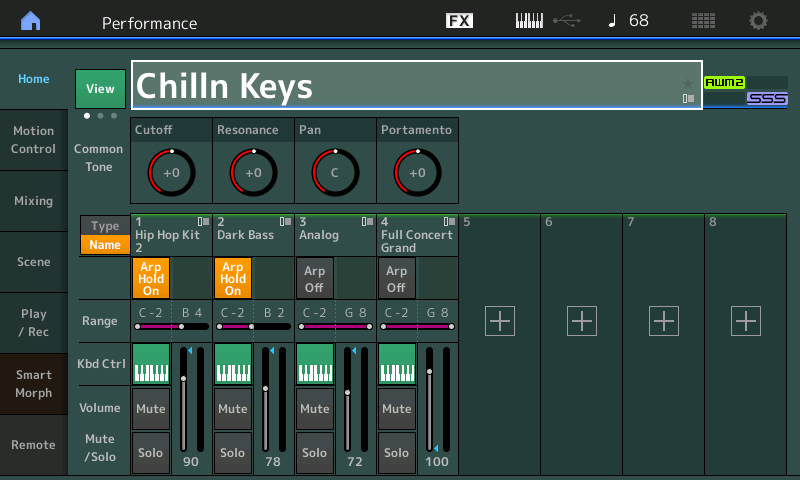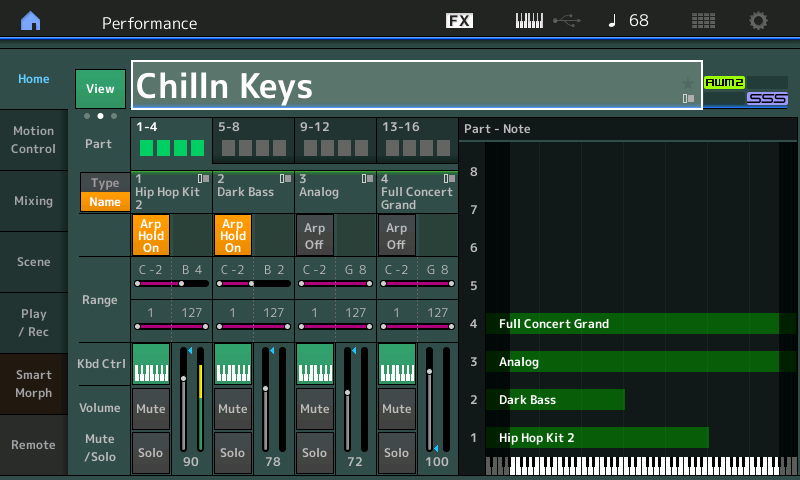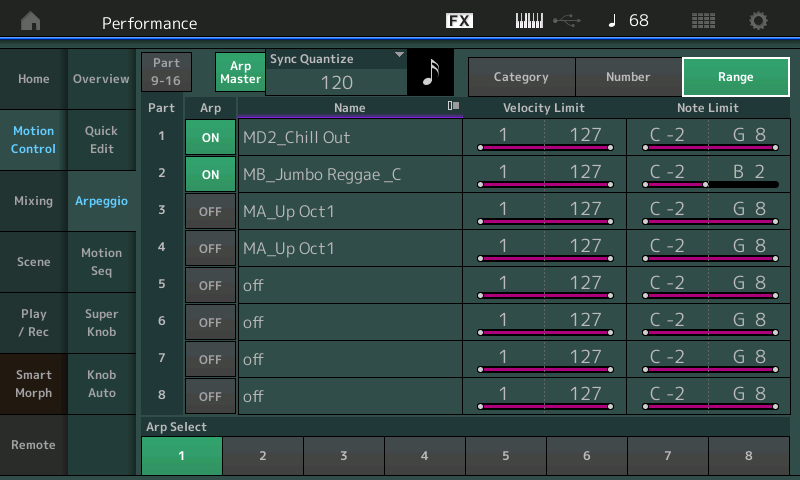Hello! I am a new user of MODX. I have a question about how eliminate lead part from impact to the bass and keyboards arpeggio chord progression. Do I have to change the keyboards range of those part or is it another way to do it? I have change the lead part!
Hello! I am a new user of MODX. I have a question about how eliminate lead part from impact to the bass and keyboards arpeggio chord progression. Do I have to change the keyboards range of those part or is it another way to do it? I have change the lead part
Hi! Thank you for the question.
Using the [PERFORMANCE (HOME)] button you can toggle through 3 views of the current Performance... simply press it to toggle the views:
View1 shows a channel strip for each Part (8 at a time) and the currently selected 8 Knobs
View2 shows a split screen with additional visual information for the mapping
View3 is the new FMX SmartMorph (when applicable)
When setting up a MODX Performance with multiple Parts... on the HOME screen, View1 (shown below), you can see the “Range” parameter setting. The full range of the MIDI keyboard is C-2 thru G8. This “Range” tells you the keyboard range you can expect to hear reproduced when asked to sound. (The drums stop at B4 because the programmer did not want the Bell-tree sound used in this particular Arp Phrase to sound — even though it is apart of the Arp Phrase, the Part Note Limit removes it from sounding).

Drums are sounding C-2 thru B4 — they are under control of an Arp set to HOLD
Bass is sounding C-2 thru B2 — the bass is under control of an Arp set to HOLD
Pad/Choir and the Piano are across all keys under real time control of the player...
HOME View2, (shown below) gives you a split screen that shows you where each Part is mapped. These are the Notes that will sound in response to being triggered. You can view both the range settings and see it referenced against the keyboard icon

If you move the cursor down to highlight a Range (Note or Velocity) you will see how you can enter data for these settings directly.
Next, touch “Motion Control” > “Arpeggio” — here you can see an overview of which Arp’s are currently going to sound... you can view the Arp Type name, when “Category” is selected; you can view the Arp Number, when “Number” is selected; and you can view the Notes that will control/trigger the Arp assigned to each Part, tap “Range” shown below:

These are the Notes and the Velocity that will Control and/or Trigger the Arp per Part. Notice currently, touching any Key will start the Drum Arp assigned to Part 1... but only a Note below B2 will start the Bass Arp in Part 2.
Say I wanted the Drum Arp in Part 1 to only start after I finished a piano introduction... I could “hide” the Trigger Key for the Drum Arp wherever I wish... say my piano intro ended on the downbeat on the Note C6... if I set the Arpeggio Note Limit = C6 thru C6. I could play without the drums until I trigger that note. Or I could set it so that the drum Arp only started if I exceed a specific Velocity ... or a specific Velocity on a specific Key etc., etc. The takeaway here is these are separate from the Limits about what pitches it will sound ... and refer only to the Arp being controlled or triggered to start.
Hint: Chord intelligent Arps are controlled by note input (they ‘reads the chord voicing
Drum Arps and Fixed Note Arps are triggered... you have no more influence beyond starting them.
The Bass Arp in Part 2 is set to be Controlled by any Notes up to B2. Even if the bass phrase plays across the keyboard, only notes from C-2 thru B2 will cause the Bass line to change. You can see the useful ness of this — particularly when wishing to control a guitar part with your left hand... you can Note Limit the Notes that *control* the Arp completely independent of the pitches that that arp reproduces.
This is only confusing to those who don’t see this difference... that you might want to control the Arp in a note range that differs from pitches it is reproducing. If you do not want what you play in the right hand to influence your bass, you would Note Limit the Notes that control that Bass Arp
Summary:
On the HOME screen you control the Part Note Limits... these you use to create Splits - where this Part will make musical tones
On the “Motion Control” > “Arpeggio” screen you set the “Range” of Notes that will Control/Trigger the particular Arp.
This becomes particularly useful when you are using Arps to execute fixed note runs, for example. You may have created a User Arp that does some impossibly difficult run... you can set it up so that the lowest key on your keyboard triggers this run (that lowest note, as you understand now) does not have to be included in the run. It can be the hidden key that sets it in motion.
You may notice, that when you assign a Part to an Arpeggio, typically, this removes your ability to play that sound directly. This is due to the Arpeggio parameter called KEY MODE. It determines whether the notes you use to activate the Arp are heard in response to your pressing that key directly. When KEY MODE is “Sort” your direct key press is not sounded... instead the key press as stored in the Arp Phrase is sounded.
And as we’ve seen that can be a completely different Note in another whole area of the Keyboard.
Hope that helps.
Tanks for that deep instructions... I have John Melas Prg. So I think i understod how to do but there are many thing to practice and rembering with Modx but I like the machine very much.
